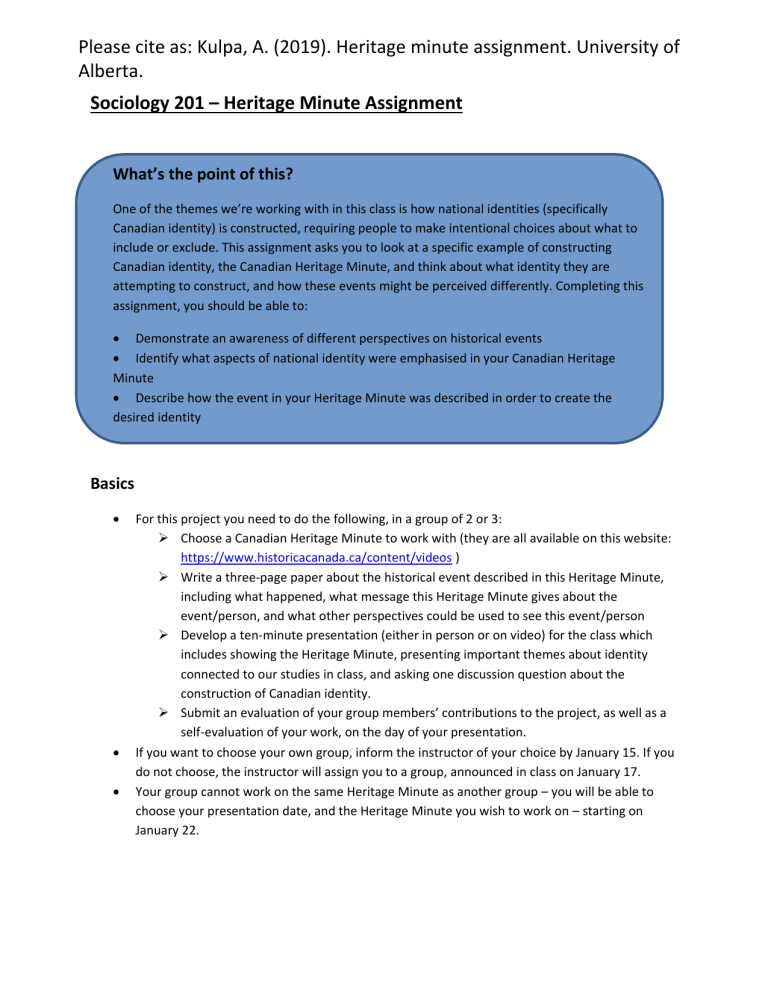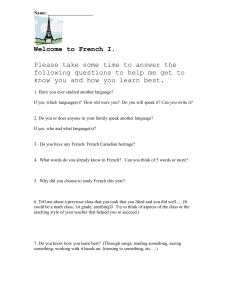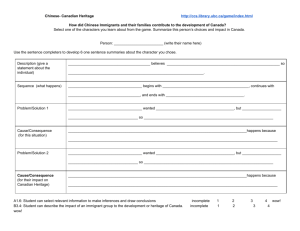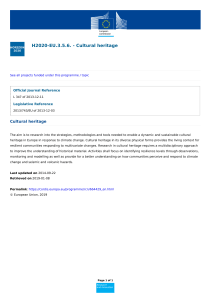
Please cite as: Kulpa, A. (2019). Heritage minute assignment. University of Alberta. Sociology 201 – Heritage Minute Assignment What’s the point of this? One of the themes we’re working with in this class is how national identities (specifically Canadian identity) is constructed, requiring people to make intentional choices about what to include or exclude. This assignment asks you to look at a specific example of constructing Canadian identity, the Canadian Heritage Minute, and think about what identity they are attempting to construct, and how these events might be perceived differently. Completing this assignment, you should be able to: • Demonstrate an awareness of different perspectives on historical events • Identify what aspects of national identity were emphasised in your Canadian Heritage Minute • Describe how the event in your Heritage Minute was described in order to create the desired identity Basics • • • For this project you need to do the following, in a group of 2 or 3: ➢ Choose a Canadian Heritage Minute to work with (they are all available on this website: https://www.historicacanada.ca/content/videos ) ➢ Write a three-page paper about the historical event described in this Heritage Minute, including what happened, what message this Heritage Minute gives about the event/person, and what other perspectives could be used to see this event/person ➢ Develop a ten-minute presentation (either in person or on video) for the class which includes showing the Heritage Minute, presenting important themes about identity connected to our studies in class, and asking one discussion question about the construction of Canadian identity. ➢ Submit an evaluation of your group members’ contributions to the project, as well as a self-evaluation of your work, on the day of your presentation. If you want to choose your own group, inform the instructor of your choice by January 15. If you do not choose, the instructor will assign you to a group, announced in class on January 17. Your group cannot work on the same Heritage Minute as another group – you will be able to choose your presentation date, and the Heritage Minute you wish to work on – starting on January 22. Written Portion (3-3.5 pages, double-spaced, /20 marks) You should do this first – the paper should guide the presentation, not the other way around. The focus of this assignment is the analysis of the Heritage Minute – not describing the historical event. In about 1/2 a page, describe the subject of your Heritage Minute. If your Minute is about a person, you should describe some of their life/work, and how the event covered here fits within that context. If your Minute is about an event, you should describe some of the context of that event (what led up to it, what else was happening at the same time, etc.). You can use your Heritage Minute and your textbook for this, and include other sources if you wish, as long as they are historically accurate. This needs to be fairly short, so make sure whatever you’re including here is important to the argument you’re making in the rest of your paper. It should also be relatively neutral – you aren’t evaluating the subject, you’re describing the facts. In about 1 page, discuss what the Heritage Minute is trying to SAY about it’s subject. You should look at how this statement might fit with other ideas about Canadian identity (other aspects, ways people like to think of themselves, etc.). You’re trying to identify what answer the Heritage Minute is giving to questions like “Why should Canadians care?,” “What does this say about Canada as a country?” and “Why is this event/person something Canadians should know about?” In this section, it’s important to focus on what the Heritage Minute is saying (e.g. about why Canadians should care), rather than making your own argument about this – what statements about Canadian identity are being made by this minute? In 1.5-2 pages, discuss what is MISSING about this subject from the Heritage Minute – other perspectives or ways of seeing things. This might mean looking at how different groups in Canada would see the subject (e.g. based on ethnicity, gender, class, etc.), or considering it on different timelines (it was good then, it’s different now, or then we thought it was a bad thing but now there’s some good come of it…). It could also mean considering how this event or person appeared to people/groups outside of the country (assuming it would matter to them). You don’t need to argue the Heritage Minute is wrong about the subject (although you can), you need to identify what/who is being left out. *** ALL group members’ names should appear on the paper when it’s submitted. *** This piece of writing doesn’t really need an introduction of conclusion – you can start by saying “Our Heritage Minute is about…” and go from there. The written portion of your assignment is due the same day as your presentation. Presentation (10 minutes, 15 marks) Your group will present their findings to the class. There are presentation dates scattered throughout the semester, beginning January 29. Most dates will have two slots available for presentations, some will have three. Your group can sign up for their presentation date, and their Heritage Minute, starting on January 22. Your group can either present in front of the class, or make a video to share. Start by showing the Heritage Minute your group has chosen. You are responsible for making sure you have technology available to do this. Present the analysis of Canadian identity you developed in your paper. You can do this in whatever way you choose, but you need to discuss what this Heritage Minute is saying about this subject/Canada/why Canadians should care about this, and what is missing if we view the subject (e.g. this event, or this person) in this way. • • • • You do not necessarily need a visual aid or PowerPoint, although you can use them. Every member of your group must be PRESENT for your presentation – there’s no requirement for everyone to speak (assuming that’s something your group agreed to), but they need to be there. Your presentation should be ENGAGING – your discussion should be interesting. Do NOT read your paper to the class. This might mean talking about how this event lead to or connects to, current events, or dramatizing perspectives, showing maps and pictures… how you do this is up to you. If you identified several perspectives or possibilities in your paper, you can focus on only one or two of them here, if you’d like. End with one question to the class about the tensions in identity construction raised by your analysis. You should present enough information about this subject that the rest of the class can discuss your question in relation to course themes. • This should be a DISCUSSION question – not a quiz. The expectation is that your classmates can engage with it, and start wrestling with the challenges presented in this aspect of Canadian identity. It shouldn’t be a question with a single correct answer. You are responsible for adhering to your presentation date – if you miss yours, or your group isn’t ready, you will get a 0. PRACTICE your presentation – 10 minutes isn’t a long time, so make sure you fit in everything you need to do in that time. I WILL cut you off if you go over time. Group Member Evaluations/Self Evaluations (5 marks for the quality of your evaluations, 10 from your group members) Every group member is expected to contribute to the INTELLECTUAL aspects of the projects. Everyone in your group needs to research your subject, be involved in the discussion of what you’re going to say about the construction of identity, and contribute to the discussion of other perspectives. It is unacceptable for two people to do the research and writing, and one person to “put it together” and make the PowerPoint presentation. This doesn’t mean you have to include all of everyone’s ideas (or that someone didn’t do their work if their ideas aren’t included in the final project) – it means that, as a group, you have to discuss WHAT to include in the final version of both the paper and presentation, and everyone needs to participate, in an informed way, in that discussion. You need to evaluate both your own work, and the work of your peers, according to these standards. The day of your presentation, submit the following, with your paper: ➢ A one paragraph (5-10 sentences) evaluation of each of your other group member’s contributions to the work, including a mark out of 10 ➢ A one paragraph (5-10 sentences) evaluation of your own contribution to the work, including a mark out of 10 *** These evaluations need to have your name on them, but should be submitted sealed (either in an envelope, or folded in half and stapled shut), so that only the instructor can read what you wrote. Your name can appear only inside the sealed form. Evaluations should describe specifically what people did or did not do. If your group member did well, I’m looking for statements like “They researched the subject, and presented a case for what this event looked like from the perspective of poor Canadians” and “They rewrote our description of the event three times to make sure everything included there was relevant to the rest of our paper.” If a group member did poorly, I want to see things like “They missed two of our group meetings,” “All they knew about the subject at our meeting was what was in the Heritage Minute,” and “They didn’t say anything when we discussed what this Heritage Minute was trying to say about Canada.” Personal attacks in evaluations will not be tolerated. Your self-evaluation should also be specific – what did you do, what didn’t you do, etc. It should reference the standards above of intellectual contribution to the project. 10 marks in this section will be based on the scores your group members assign to you, although the instructor reserves the right to modify these scores. The remaining 5 marks will be assigned based on the quality of evaluations you write of yourself and your peers (do they include specifics, are they fair, etc.).





